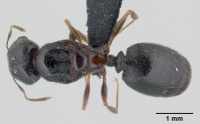Pheidole komori
| Pheidole komori | |
|---|---|

| |
| Scientific classification | |
| Kingdom: | Animalia |
| Phylum: | Arthropoda |
| Class: | Insecta |
| Order: | Hymenoptera |
| Family: | Formicidae |
| Subfamily: | Myrmicinae |
| Tribe: | Attini |
| Genus: | Pheidole |
| Species: | P. komori |
| Binomial name | |
| Pheidole komori Fischer & Fisher, 2013 | |
Pheidole komori has been collected in dry forest, coastal scrub land, or along a roadside, and all at elevations between 5 and 50 m from two islands of the Comoros – Moheli and Anjouan. It has also been collected from secondary forest and sand forest in Gorongosa National Park in Mozambique.
Identification
Fischer and Fisher (2013) - Moderately large species (WL majors 1.12–1.20 mm, WL minors 0.76–0.83 mm), minor workers with relatively long scapes and legs (SI 120–144, FI 123–156), major workers with relatively short scapes (SI 49– 50) and moderately long legs (FI 68–73), both with angulate promesonotal process present and angulate. Major postpetiole with small, acute ventral process and head distinctly longer than wide (CI 82–88). Antennal scrobe absent, posterolateral lobes smooth and shiny or with short weak rugulae, hypostomal margin with submedian teeth relatively large and median process well developed. Minor postpetiolar ventral process conspicuous, postpetiole on average 1.1 times wider than long (DPpI 106–115).
This species could belong to a yet undefined Afrotropical species group, and may be related to morphologically similar species like Pheidole strator from Eritrea, Pheidole strator fugax from Mozambique, or Pheidole schultzei gwaaiensis from Zimbabwe. The presence of this species in Africa along with related species suggests that P. komori most probably has an Afrotropical origin and did not originate in the Comoros. In the Malagasy region, this medium-sized Pheidole is easily distinguished from the teneriffana group and other species revised here by minor workers that combine a distinct promesonotal posterior process with a convex postpetiolar ventral process and major workers that combine the distinct promesonotal posterior process with a more elongate head shape and posterolateral lobes that are not rugose or reticulate.
Keys including this Species
Distribution
Latitudinal Distribution Pattern
Latitudinal Range: -12.1964° to -19.08027778°.
| North Temperate |
North Subtropical |
Tropical | South Subtropical |
South Temperate |
- Source: AntMaps
Distribution based on Regional Taxon Lists
Afrotropical Region: Comoros (type locality), Mozambique.
Distribution based on AntMaps
Distribution based on AntWeb specimens
Check data from AntWeb
Countries Occupied
| Number of countries occupied by this species based on AntWiki Regional Taxon Lists. In general, fewer countries occupied indicates a narrower range, while more countries indicates a more widespread species. |

|
Estimated Abundance
| Relative abundance based on number of AntMaps records per species (this species within the purple bar). Fewer records (to the left) indicates a less abundant/encountered species while more records (to the right) indicates more abundant/encountered species. |

|
Biology
Castes
Images from AntWeb
 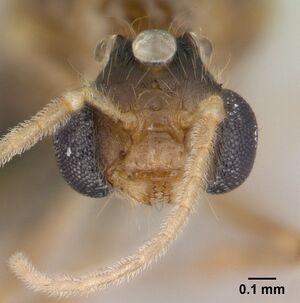    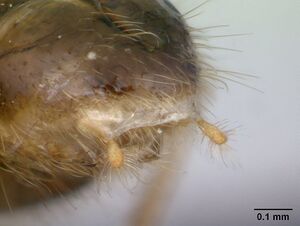
| |
| Paratype of Pheidole komori. Male (alate). Specimen code casent0147144. Photographer Erin Prado, uploaded by California Academy of Sciences. | Owned by CAS, San Francisco, CA, USA. |
   
| |
| Paratype of Pheidole komori. Worker. Specimen code casent0147145. Photographer Erin Prado, uploaded by California Academy of Sciences. | Owned by CAS, San Francisco, CA, USA. |
  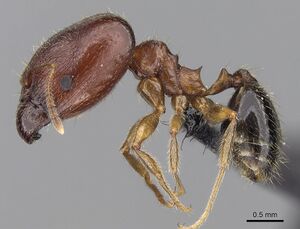 
| |
| Holotype of Pheidole komori. Worker (major/soldier). Specimen code casent0147188. Photographer Estella Ortega, uploaded by California Academy of Sciences. | Owned by CAS, San Francisco, CA, USA. |
   
| |
| Paratype of Pheidole komori. Worker. Specimen code casent0149121. Photographer Estella Ortega, uploaded by California Academy of Sciences. | Owned by CAS, San Francisco, CA, USA. |
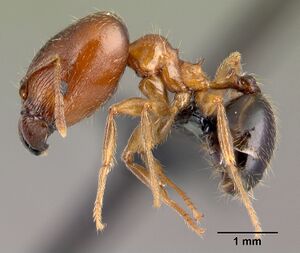   
| |
| Paratype of Pheidole komori. Worker (major/soldier). Specimen code casent0179500. Photographer Erin Prado, uploaded by California Academy of Sciences. | Owned by CAS, San Francisco, CA, USA. |
 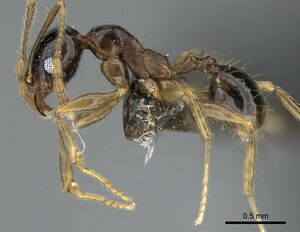  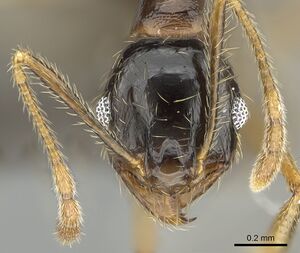
| |
| Worker. Specimen code casent0319245. Photographer Michele Esposito, uploaded by California Academy of Sciences. | |
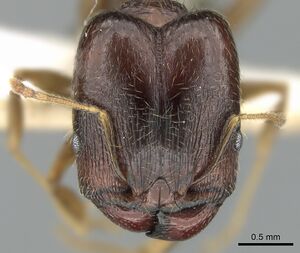   
| |
| Worker (major/soldier). Specimen code casent0319246. Photographer Estella Ortega, uploaded by California Academy of Sciences. | |
Nomenclature
The following information is derived from Barry Bolton's Online Catalogue of the Ants of the World.
- komori. Pheidole komori Fischer & Fisher, 2013: 328, figs. 19A-F (s.w.) COMOROS.
Unless otherwise noted the text for the remainder of this section is reported from the publication that includes the original description.
Description
Worker
Major (holotype): HW 1.49, HL 1.76, SL 0.71, MDL 0.78, EL 0.20, WL 1.13, PNH 0.48, PNW 0.65, MNH 0.80, PDH 0.40, PTL 0.45, PPL 0.27, PTH 0.27, PPH 0.29, PTW 0.23, PPW 0.45, PSL 0.18, MFL 1.05, MTL 0.77, CI 85, SI 48, MDI 52, EI 13, FI 70, PSLI 12, LPpI 93, DPpI 167, PpWI 196, PpLI 60, PpHI 107.
(n=4): HW 1.40–1.48 (1.45), HL 1.69–1.81 (1.73), SL 0.70–0.73 (0.72), MDL 0.70–0.78 (0.75), EL 0.20, WL 1.12–1.20 (1.16), PNH 0.49–0.51 (0.50), PNW 0.63–0.67 (0.64), MNH 0.75–0.80 (0.78), PDH 0.36–0.41 (0.39), PTL 0.42–0.48 (0.44), PPL 0.25–0.28 (0.26), PTH 0.26–0.29 (0.27), PPH 0.26–0.31 (0.28), PTW 0.21–0.24 (0.22), PPW 0.41–0.52 (0.45), PSL 0.15–0.22 (0.19), MFL 1.01–1.06 (1.03), MTL 0.75–0.77 (0.76), CI 82–88 (84), SI 49–50 (49), MDI 47–54 (51), EI 14–14 (14), FI 68–73 (71), PSLI 11–15 (13), LPpI 89– 100 (93), DPpI 158–186 (169), PpWI 195–217 (204), PpLI 58–63 (61), PpHI 100–108 (104).
Head distinctly longer than wide (CI 82–88), wider posteriorly than anteriorly, sides convex. Mandibles smooth and shiny, clypeus smooth with well-defined median carina and few weak to superficial lateral carinae. Frontal carinae very short or inconspicuous, antennal scrobe absent. Frons longitudinally rugose, rugae at sides of head more irregular, to sometimes weakly rugoreticulate, interspaces weakly to superficially punctate. Posterolateral lobes smooth and shiny, or with some short and weak, occasionally half-circular, rugulae. Scape relatively short (SI 49–50) with decumbent pilosity and two or three longer, subdecumbent to suberect hairs present along outer edge. Hypostomal margin with submedian teeth conspicuous and median process well developed. Promesonotum relatively high, posterior process well developed, in profile right-angulate, with concave transverse groove, and steep posterior declivity. Surface of pronotum smooth to superficially punctate, sometimes with few interrupted transverse rugulae at anterior and posterior ends. Mesonotum and propodeum weakly punctate with large smooth and shiny area on katepisternum and smooth to superficially punctate dorsopropodeum. Metanotal groove in profile inconspicuous to barely impressed, cross-ribs weakly developed with reduced sculpture in between. Propodeal spines moderately short-spinose (PSLI 11–15). Metafemur moderately long (FI 68–73), metatibia with decumbent pilosity, along outer edge with additional longer suberect to subdecumbent hairs. Dorsum of waist segments smooth anteriorly, sometimes grading to superficially punctate posteriorly, remainder punctate. Postpetiole on average about 1.7 times wider than long (DPpI 158–186) and twice as wide as petiole (PpWI 195–217), ventral process small to minute, acute, and directed anteriorly. Gaster smooth. Standing hairs relatively abundant and short, yellowish, moderately acute, and stiff. Shorter pilosity decumbent and slightly more abundant than longer hairs. Color brown; mandibles, postpetiole, and gaster darker.
Minor (n=5): HW 0.48–0.56 (0.53), HL 0.60–0.65 (0.64), SL 0.64– 0.69 (0.67), MDL 0.38–0.41 (0.40), EL 0.13–0.14 (0.13), WL 0.76–0.83 (0.79), PNH 0.27–0.28 (0.28), PNW 0.35–0.38 (0.36), MNH 0.49–0.53 (0.51), PDH 0.24–0.27 (0.25), PTL 0.24–0.28 (0.26), PPL 0.15–0.17 (0.16), PTH 0.14–0.15 (0.14), PPH 0.14–0.15 (0.14), PTW 0.09–0.10 (0.10), PPW 0.17–0.19 (0.18), PSL 0.06–0.07 (0.06), MFL 0.69–0.77 (0.72), MTL 0.52–0.58 (0.55), CI 74–88 (84), SI 120–144 (126), MDI 70–85 (75), EI 23– 27 (25), FI 123–156 (136), PSLI 10–14 (11), LPpI 106–115 (111), DPpI 59–69 (63), PpWI 96–107 (100), PpLI 59– 69 (63), PpHI 96–107 (100).
Head shape suboval, longer than wide (CI 74–88), sides convex, posterior head margin transverse, with rounded corners, occipital carina not visible in full-face view. Mandibles relatively long (MDI 70–85), smooth. Clypeus smooth, median and lateral carinae absent or inconspicuous. Face smooth and partly micropunctate, one or two concentric rugulae present around antennal insertion. Scapes distinctly longer than head (SI 120–149), when laid back surpassing posterior head margin by about the length of tenth funicular segment., pilosity subdecumbent to suberect. Pronotum in profile flatly convex, promesonotal process well developed, obliquely angulate, and prominently produced. Metanotal groove in profile narrowly impressed, cross-ribs weak to inconspicuous. Propodeum in profile longer than high, with highest point immediately behind metanotal groove, declining evenly toward spines. Propodeal spines very short-triangular and acute, much shorter than distance between their bases (PSLI 10–14). Promesonotum largely smooth, often micropunctate and sometimes with faint, short, irregular rugulae. Mesopleuron and propodeum mostly weakly punctate, sculpture on katepisternum in some specimens partly effaced. Metafemur relatively long (FI 123–156), metatibia pilosity decumbent to subdecumbent. Postpetiole slightly longer than high (LPpI 107–118) and significantly shorter than petiole (PpLI 59–69), relatively small convex postpetiolar ventral process present, dorsum of petiole and postpetiole mostly smooth, remainder weakly to superficially punctate. Gaster smooth and shiny. Sanding hairs relatively short, scarce, stiff, blunt, and erect to suberect. Shorter pilosity slightly more abundant on head and mesosoma, mostly decumbent. Head, promesonotum, postpetiole and gaster brown to dark brown, with significantly lighter colored mandibles, metapleuron, propodeum, legs, and petiole.
Type Material
Holotype: (major worker), COMOROS, Mohéli, Lac Boundouni, 12.3792 S, 43.8517 E, 25m, dry forest, ground forager (s), collection code BLF20787, 20.i.2009 (B.L. Fisher et al.) (California Academy of Sciences: CASENT0147188). Paratypes: (1 major & 2 minor workers) same data as holotype, collection code BLF20777 (CASC: CASENT0147136); (1 major & 3 minor workers) Mohéli, Lac Boundouni, 12.3792 S, 43.8517 E, 25m, dry forest, under stone, collection code BLF20809, 20.i.2009 (B.L. Fisher et al.) (CASC: CASENT0147143– CASENT0147145, CASENT0147500); (1 major & 8 minor workers) Mohéli, Lac Boundouni, 12.3792 S, 43.8517 E, 25m, dry forest, sifted leaf litter, collection code BLF20824, 20.i.2009 (B.L. Fisher et al.) (The Natural History Museum: CASENT0149204; CASC: CASENT0149121, CASENT0149200, CASENT0149201, CASENT0149203; Museum of Comparative Zoology: CASENT0149205; Musee d'Histoire Naturelle Genève: CASENT0149207, South African Museum: CASENT0149209).
Etymology
This species’ name is a short form of the Comoros’ name ‘Udzima wa Komori’ in the local language (Shikomor). The name is a noun in apposition and thus invariable.
References
- Fischer, G. & Fisher, B.L. 2013. A revision of Pheidole Westwood (Hymenoptera: Formicidae) in the islands of the Southwest Indian Ocean and designation of a neotype for the invasive Pheidole megacephala. Zootaxa 3683, 301–356.
References based on Global Ant Biodiversity Informatics
- Fischer G. & Fisher B. L. 2013. A revision of Pheidole Westwood (Hymenoptera: Formicidae) in the islands of the Southwest Indian Ocean and designation of a neotype for the invasive Pheidole megacephala. Zootaxa 3683: 301-356

